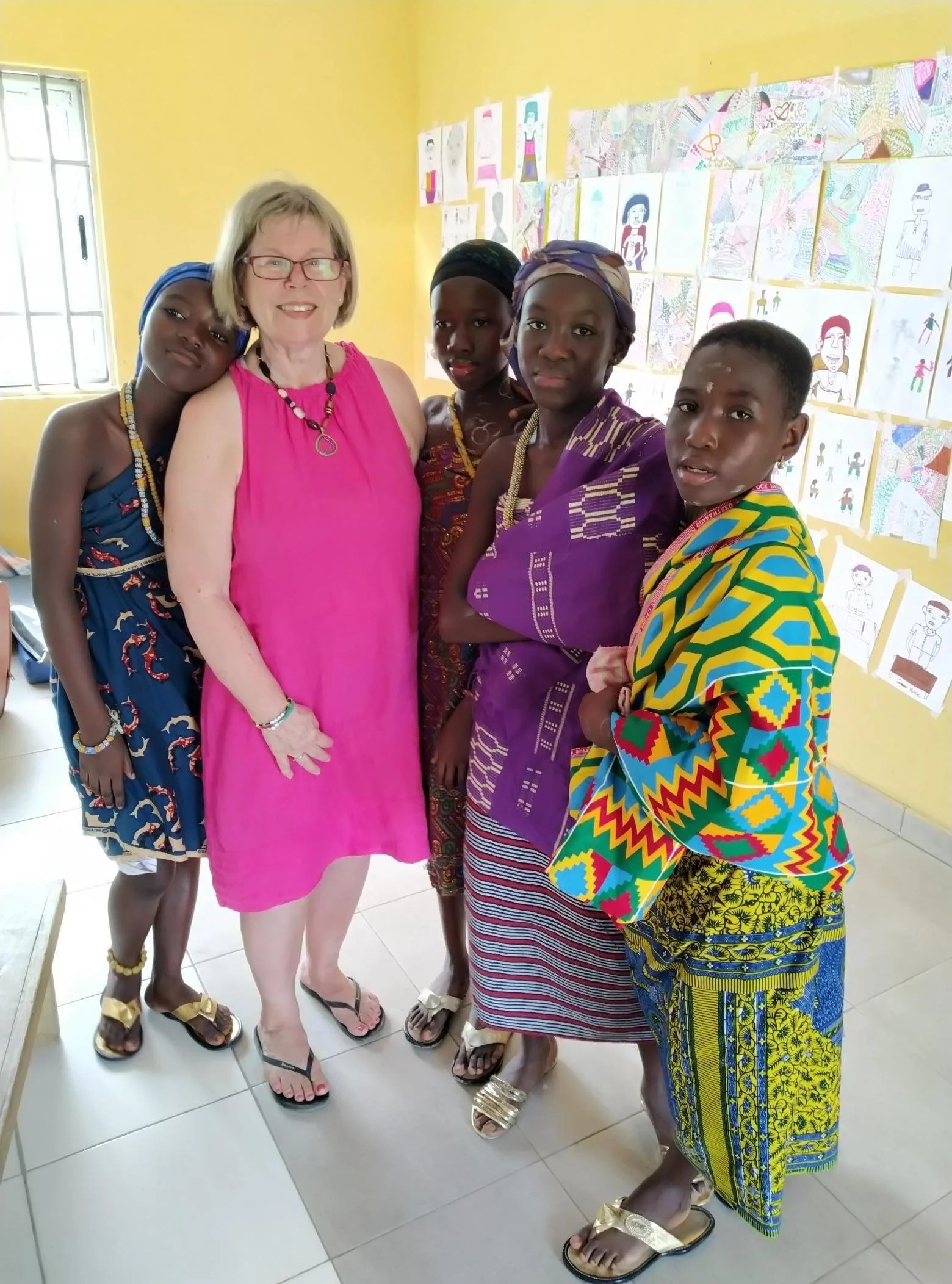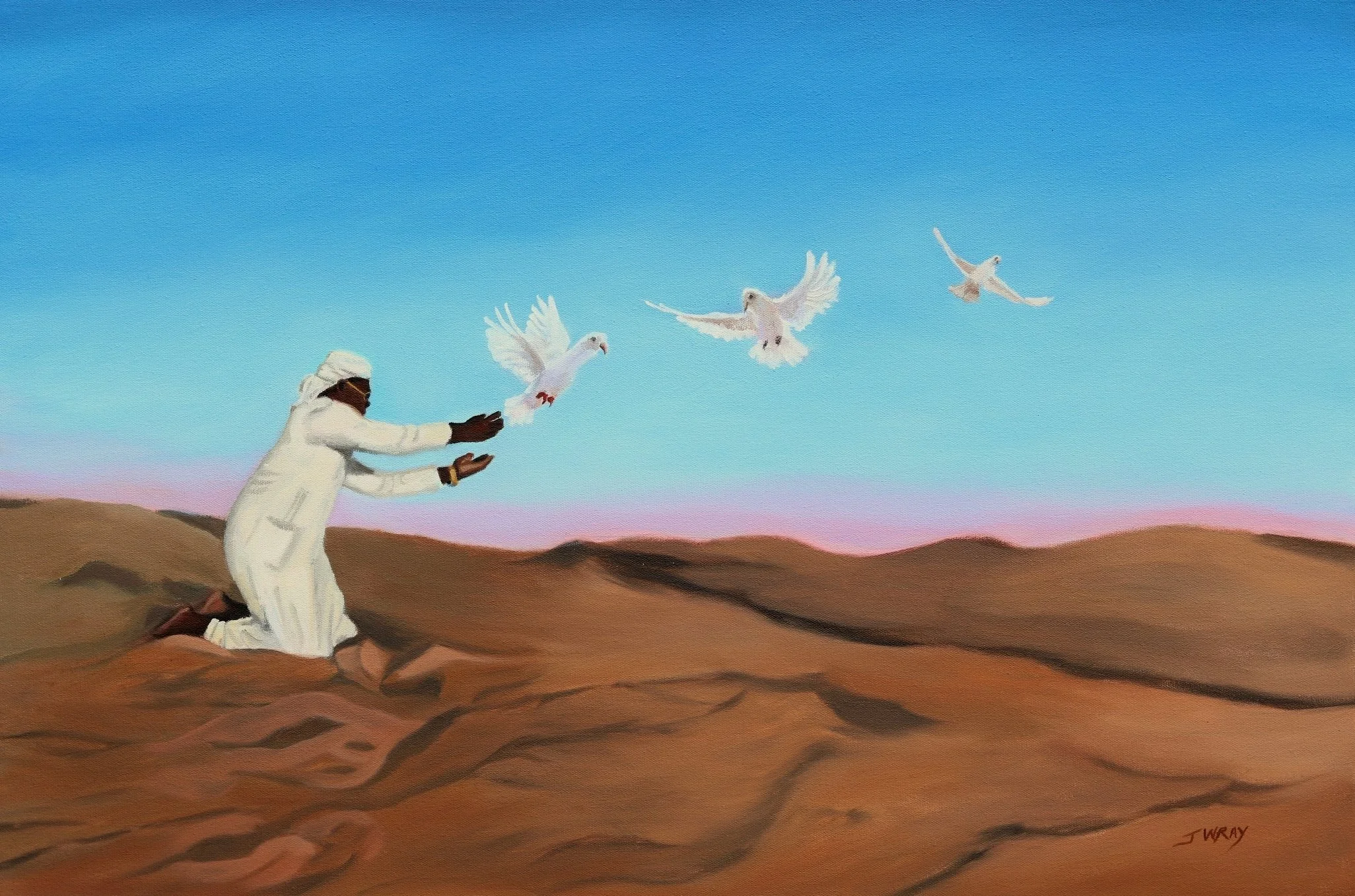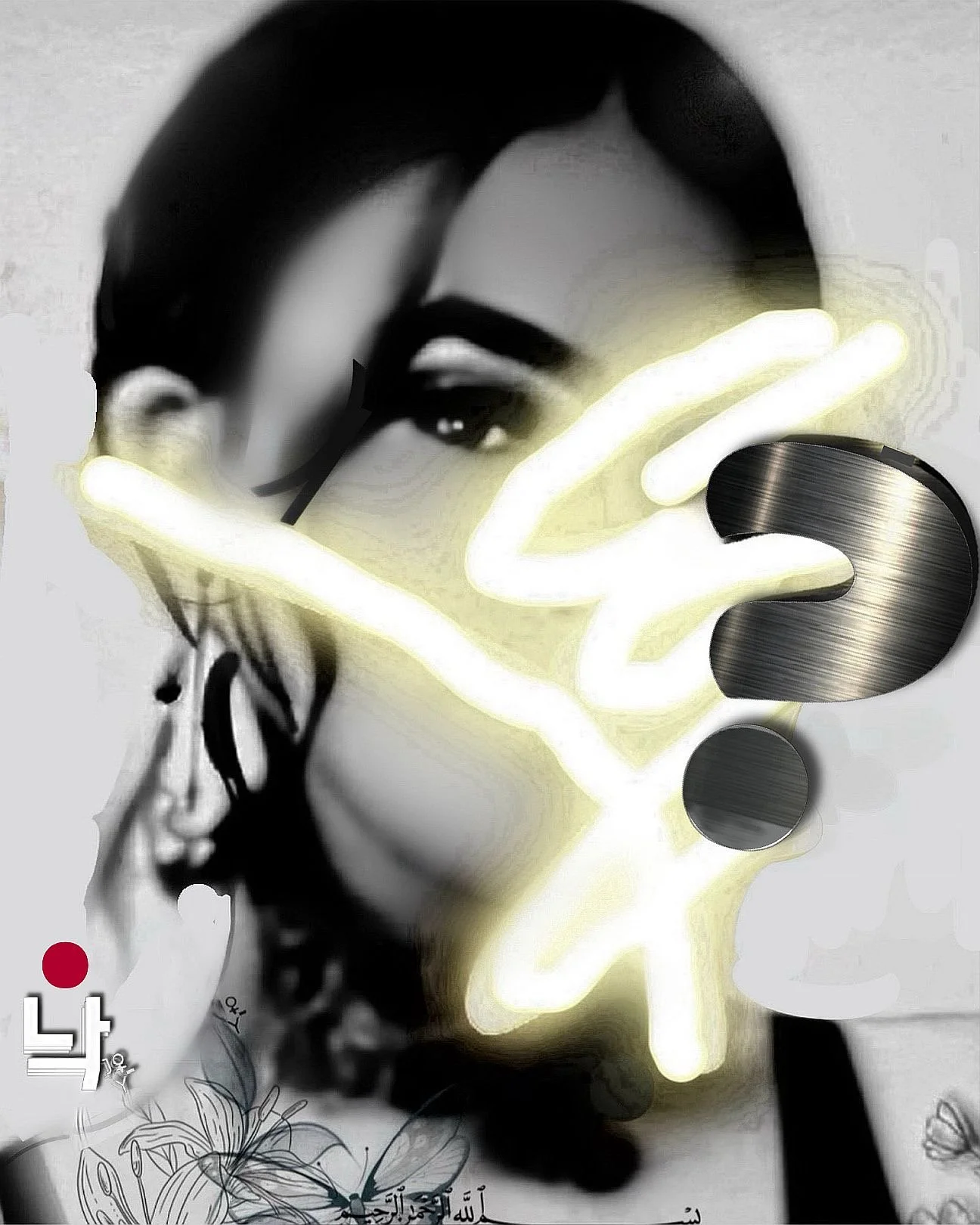Interview with Johanna Wray
It began with deceit. But instead of turning my head in disgust, I decided to investigate; this is, after all, a person on the line, I thought. In doing so, a whole New World opened up to me, a world full of mystery and intrigue a continent away.
I had to think carefully about this. Do I paint a series of West African portraits, telling their stories or not? I knew it would be controversial. Topics like cultural misappropriation, inequity, economics, social injustice, discrimination and governance would be brought to the forefront. But I could not turn my head . . . it was too late. And thus I embarked on the most exciting and stressful project of my life!
I am primarily a figures and portrait artist. I selected 6 individuals and 2 charities for the project. They are from Ghana, Uganda, and Nigeria. The participants know they are part of an art exhibition consisting of 14 paintings, a video loop and an oral recitation of some of the essays they wrote for me. These West Africans are very interested in having a voice in the Western World. To be fair, I paid each one of them for the images, videos and essays. I do not stand to profit financially from this project in any way. The project spanned three years; September, 2021 to September 2024.
Reflecting on your one month-long teaching experience in a remote Ghanaian village, can you delve into the nuanced ways in which this immersion has catalyzed your artistic process and conceptual framework for the “African Connection” series? How did these lived experiences manifest in the symbolism and thematic undertones of your paintings?
I stayed a month in Ghana near the end of the project; two weeks in the bustling city of Accra and two weeks teaching in the remote village of Frankadua in the Volta Region. All the paintings were mostly complete by that time. The texting and talking with these 8 individuals while painting them or the images they sent, influenced the work the most. I involved the participants in the creation of each painting, so it was a joint effort. Most of the paintings are contemporary realism and some are surreal in nature. All evoke a mood or atmosphere. The lived experience had a great impact on me in that the stories I had been told were entirely true and the situations became vividly clear to me.
In portraying the intricate lives of West Africans, how do you navigate the tension between your subjective artistic vision and the objective reality of their stories? How do you ensure that your aesthetic choices do not overshadow the authenticity and integrity of their lived experiences, and what philosophical frameworks guide you in this ethical balancing act?
I involved each participant in my painting process. The way I paint with oils is in a series of layers. Usually I will paint in three hour sessions and then that layer has to dry for a week. Most paintings take me six months to a year to complete!
I am a “people” person and try my best to show everyone I meet my utmost respect. It doesn’t matter to me if a person is poor, rich, uneducated, highly educated, a person of prominence or not . . . I try to treat them all the same. Wealth, showy things, do not impress me. I dislike inequity. I suppose that is one of the reasons I decided to undertake this project.
Secondly, I immigrated with my family to Canada in 1956. Many people were very poor at the time. There were many immigrants flooding into Canada. The Canadian government gave my parents $600 to make the trip. Europeans were uprooted and introduced to a new, unknown country. My dad, especially, did not have any marketable skills or knowledge of the English language. I know what struggles my parents went through to provide for their family. So I have experienced poverty in my life and it marks you. You don’t forget it. The West Africans enjoyed my immigration stories and I made a connection with them this way. Although, my level of poverty was never the same as some of them are facing today.
Considering your European heritage and Canadian upbringing, how has your personal journey of identity and cultural assimilation influenced your portrayal of West African subjects? What philosophical reflections have emerged for you regarding the nature of identity, otherness, and the artist’s role in bridging these cultural and existential gaps?
I believe that my immigration experience has led me to embrace other cultures. I realize how fortunate I am to live in Canada, a free country with endless possibilities.
I was fortunate to experience Africa Day and Independence Day in Ghana when I was there. West Africans are proud of their heritage and their resilience to difficult situations. Their lives are very hard and there is not much opportunity to better your situation. Yet, they display love, joy and faith in leaps and bounds over people in my country. “We cherish each other. We are all we have . . .each other”, says Elvis, the Volunteer Coordinator in Frankadua. This is what really stood out for me, the love and respect that the community had for each other and for me. I was most surprised by this. This is what touches you . . . most people that have visited Africa have said that they left part of their soul there. It is an unforgettable experience.
Art transcends borders, space and time. We are all humans after all with the same desires; love, family, meaningful work, a roof over our heads and some food in our bellies.
Your “African Connection” series positions itself within a broader sociopolitical context. How do you see your work contributing to the discourse on contemporary African issues, and what philosophical implications do you believe your series carries for the global understanding of Africa’s multifaceted realities?
The participants are hoping that this series will change the narrow way the rest of the world sees them: as scumbags and scammers. I believe that the stories that go along with each painting, the videos and the recitation of some of the essays the participants have written for me will engage the viewer to think more broadly about West Africa. Some of the problems come to light in the stories. Each painting has a story behind it.
This series will definitely open up conversations of inequity, social injustice, economics, governance, overpopulation and discrimination. That’s why I was hesitant at first to tackle the project, afraid of any fallout I might experience in my artistic career and/or family circle.
Engaging with individuals from vastly different cultural backgrounds introduces a spectrum of ethical considerations. Can you elaborate on the specific ethical challenges you encountered in this artistic collaboration and how you addressed them to maintain both artistic integrity and cultural sensitivity?
Well, because you are white, the Africans assume that you are rich. The most difficult thing for me was the requests for money. I did pay each participant for the images I used, videos they sent me and the essays they wrote. I have financially helped each one of them in different ways. But I had to set a rule, if they kept asking for money, they would be removed from the project. I did have to do this in one case.
I suppose this was the most stressful part for me. Knowing that I cannot help everyone in Africa! There was also backlash from family and friends, they felt that I shouldn’t be talking with Africans let alone sending them money. That was stress-or number two. But I was convinced I was doing the right thing and the project greatly interested me. I have always been very curious about how other people live and discovering cultural differences.
Some sensitivities would include the following; not to show pictures of food if the person hadn’t eaten that day, or not to flaunt wealth in any way. That is difficult because in video chats they can see how you live, they actually want to see it. But when you know they are living in a cubicle and have no food that day, makes it difficult. I truly believe that part was more difficult for me than for them. Whenever I said, I am sorry but I cannot help you at this time, they were all very understanding and accepting. And that was beautiful.
Your artistic journey spans Europe, North America and now African contexts. How has this diverse geocultural exposure influenced your evolving artistic style and thematic exploration, particularly in the context of the “African Connection” series? What philosophical insights have you garnered from these varied cultural landscapes?
For the first time I was painting black skin tones in oils. The color mixing is quite different from painting white flesh tones, so, being mainly a portrait artist, this greatly interested me. It was something new to explore. There are many types of black skin ranging from almond, caramel, java, espresso, ebony and deep ebony. Beautiful blue and purple undertones in some and warm orange tints in others.
Video chats exposed cultural celebrations, ways of life, food preparation, fashion, exploration of music etc. All the participants were excited to share recipes, cultural celebrations, afro-beat music and their spiritual leanings. I honestly felt a deep connection with each of the participants after three years of conversations. They have certainly enriched my life and I know I have enriched theirs also.
In the process of creating your series, what were the most profound insights or paradigm shifts you experienced through your cultural exchanges with the African individuals? How has this bidirectional dialogue deepened your understanding of the philosophical role of art in fostering cross-cultural empathy and understanding?
I was so impressed with the intelligent and talented people that I have been talking with. I am so happy that I took on this very lengthy and difficult project. West Africans would love to have the same opportunities for advancement as we have here. They are definitely frustrated with the lack of possibility for advancement in their lives. They want to work hard, but there are no jobs. And when you can find a job they are mostly underpaid or payment may not be on time. Also, if you become ill you are often terminated from your job. They are living under a great deal of stress. The average age of the population is 19. A very young demographic on which it is difficult to build a strong economy.
The portraits and stories should bring some level of understanding from this side.
Given that digital platforms facilitated your initial connections with the West African individuals you portray, how do you reconcile the dichotomy between the digital mediation of these relationships and the tactile process of painting? What philosophical considerations inform your approach to integrating technology with traditional art forms in this series?
Modern technology allows us to enter peoples’ homes and private lives. It gives us a better understanding of each other in a global context. Having chatted with the project participants for almost three years before I traveled to Ghana, I was totally comfortable being a white woman living among blacks. Most times I forgot my color, I didn’t see it. Also, English is the language West Africans have in common, so as a visitor, it is easy to get around. What links us, in any case, is conversation, whether it be through digital media or viewing a painting. Art usually reflects the societal situations at the time, giving us a glimpse of social history in the spectrum of human evolution.
Over the three year journey of creating the “African Connection” series, how have you experienced personal and artistic transformation? Can you articulate the philosophical and existential challenges you faced, and how these have contributed to your growth and the evolution of your artistic voice?
My artistic voice has been developing over the past 35 years. I started with landscape painting, rendering things or scenes that were beautiful to me at the time. Painting made me feel calm in a busy world. Since 2017, I have been painting portraits and figures mostly, starting with the “Selfie-Portrait” series in 2017. In that series I was capturing the emerging phenomenon of young people taking selfies of themselves en mass, creating a whole new genre in art. Peoples’ private lives became public, almost overnight.
With the “African Connection” series, the dialogue is to try to change the narrow view we have of Africans in the Western World. I felt that getting to know a few and telling their stories, talking about them, would help people in my corner see that really they are not much different than ourselves. They have hopes, dreams and goals just like we do on this side. With modern technology, it is easier to cross borders and explore things and situations than ever before, I am just taking advantage of this opportunity.
I feel the “African Connection” series, contain the most significant works of my career.
As you look beyond the completion of the “African Connection” series. What future projects or thematic inquiries excite you? How do you envision your artistic practice evolving, and what philosophical questions or ideas do you wish to explore further in your future work?
I think I will leave portraiture and oils for awhile and paint “Shadows” in watercolors for my next series. I have been gathering reference material for this for the past couple of years. After that, or simultaneously, I am thinking about exploring the beautiful textiles of Ghana and somehow weaving them into landscapes or portraiture in some way. I will have to contemplate about that, let that idea “gel” in my brain for a while. (Laughs)
"Francisca & Bright" 18"W x 24"H Oil on Canvas Techiman, Ghana
" Ghanaian Cowgirl" 24"W x 18"H Oil on Canvas Techiman, Ghana
"House of Gucci" 20"W x 20"H Oil on Canvas Sapele, Nigeria
"Joy" 12"W x 12"H Oil on Canvas Mityana, Uganda
"No Lies" 12"W x 12"H Oil on Canvas Port Harcourt, Nigeria
"Nwafor" 16"W x 20"H Oil on Canvas Warri, Nigeria
"Precious" 18"W x 24"H Mixed Media Lagos, Nigeria
"Richard's Dream" 24"W x 18"H Oil on Canvas Warri, Nigeria
"Spotlight" 18"W x 24"H Oil on Canvas Edmonton, Canada
"The Game" 18"W x 24"H Oil on Canvas Port Harcourt, Nigeria
"When Doves Cry" 30"W x 20"H Oil on Canvas Warri, Nigeria

















